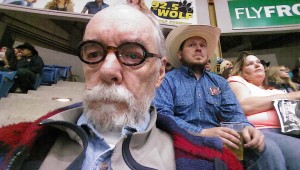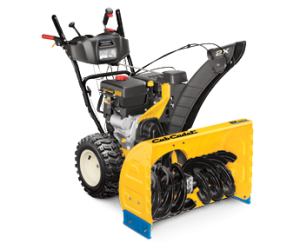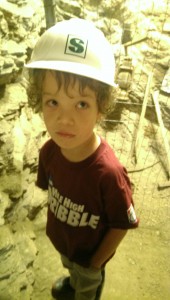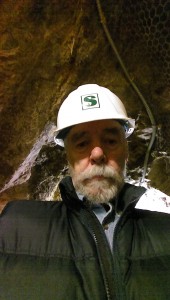Spring New (Beltane) Moon
Yesterday. Morning, afternoon and evening.
Spring New (Beltane) Moon
 So. There is background noise, the hard-drive chitters quietly, like a squirrel hunting for a nut. Now, where did I put that damned thing? I say I’m calm, not afraid, not anxious but I think that puts my persona out there, where I want me to be. Underneath the persona where we all live our most private of lives a gyroscope of concern works away, wobbling, righting itself, but never able to spin down completely.
So. There is background noise, the hard-drive chitters quietly, like a squirrel hunting for a nut. Now, where did I put that damned thing? I say I’m calm, not afraid, not anxious but I think that puts my persona out there, where I want me to be. Underneath the persona where we all live our most private of lives a gyroscope of concern works away, wobbling, righting itself, but never able to spin down completely.
How do I know? Example. On my way in to the Rodeo All Stars I went to the post office to drop off some bills. I did that. Then, as I got down the slope to Highway 285 North I checked for the envelope that had my tickets and parking passes. Uh oh. Not there. Wait a minute. Slap forehead. Yes, I had “mailed” my tickets and parking passes in the driveby mailbox.
At first I thought, well, that’s done. I’ve got to go home. Then, no, what would you say? Go back and ask. If you don’t ask, you don’t get. So I drove back to the post office. Closed. Well, damn. Then a gray haired lady opened the door. She had hear me rattling the door, looking forlorn. “Can I help you?”
Moments later we were out at the mailbox. She turned a key, got out a white plastic bin and sure enough, under the bills was my envelope from the Rodeo All Stars. I thanked her and drove into Denver.
Spring New (Beltane) Moon
More snow this morning, maybe 2-3 inches. According to Weather5280 we had 24″ by midday yesterday. So, maybe 27″ now with more snow forecast for tonight, 1-3″. It’s not hard to see that we might reach 3 feet before the whole system moves out on Sunday. That’s a lot of snow. Moisture wise it amounts to something like 3 inches of rain. All needed and welcome.
Though. I do need to blow the driveway this morning. And this is heavy, wet snow. The kind that plugs up snowblowers and makes the task harder.
The Rodeo All-Stars event on the National Western Stockshow grounds started last night, but I missed the first round. Too much snow here. However, I don’t want to miss the whole event, which has another semi-final rodeo today at 2:30 pm and the finals at 7:00 pm.
So I’ll push my little yellow Cadet out into the snow. It has a special tool for unplugging, an innovation which eliminates the need for wooden spoons or other makeshift devices. The manual and the safety stickers on the snowblower remind the user not to stick their hands into the auger while it’s running. Which common sense, too, would warn against.
Spring Mountain Spring Moon
 Gabe and I had an adventure yesterday. We went to the Agro Mine Tour, ate lunch at Beau Jo’s Pizza in Idaho Springs and finished off the day with a soporific soak at the Indian Hot Springs, also in Idaho Springs.
Gabe and I had an adventure yesterday. We went to the Agro Mine Tour, ate lunch at Beau Jo’s Pizza in Idaho Springs and finished off the day with a soporific soak at the Indian Hot Springs, also in Idaho Springs.
The mine tour itself is a cheesy, tourist-trappy thing with a clunky video, corny presentations and a self-guided tour after that. Still, the Double Eagle Mine, Gage is at its face (end) in this photo is remarkable in that it was dug by hand, by two men over the course of one year. About three hundred feet long, maybe five and a half feet tall and about 4 feet or so in width, it’s a monument to persistence, if nothing else.
The rest of the tour focuses not on a mine, but on the Agro mill, which in its prime, produced $100,000,000 worth of gold when gold was at $18-35 an ounce. It was fed by the Agro tunnel, a 4.5 mile tunnel dug through solid rock to remove waste water from various mines and to create a small railroad to deliver ore buckets to the Agro mill.
The Agro mill closed in 1943 when, on the last blast of the day, four unlucky miners  dynamited a wall holding back water filling up an abandoned silver mine. The resulting flood geysered water from the tunnel for 9 hours. In addition to killing the miners the flood weakened walls and caused cave-ins along the tunnels length making the railroad tracks no longer usable.
dynamited a wall holding back water filling up an abandoned silver mine. The resulting flood geysered water from the tunnel for 9 hours. In addition to killing the miners the flood weakened walls and caused cave-ins along the tunnels length making the railroad tracks no longer usable.
The mill itself went down in stairstep like levels since most of the work proceeded through the aid of gravity. The Agro tunnel fed ore in from the top of the mill and the processing went in stages toward the bottom. A structure made of wood it looked like an unsafe place to have worked.
Idaho Springs is about 30 minutes outside of Denver to the west and well into the mountains. The Colorado Mineral Belt, which begins in the San Juan Mountains in the far southern part of the state, makes an arc up through Leadville and finds its terminus just a bit further north from Idaho Springs. Along this arc lie most of the mines in Colorado, many of them producing, like the mines the Agro Mill serviced gold, silver, copper, lead and zinc. Some have molybdenum and other metals. There’s a big, working molybdenum mine outside of Leadville.
Idaho Springs is a tourist town, primarily, located on either side of a long main street paralleling I-70. It has some residential housing, but not much. Service stations, inexpensive motels, restaurants, curio shops, a knife shop, a hardware store which sells gold panning supplies, that sort of thing.
And the Indian Hot Springs. The facilities, both the main building and the adjoining motel, saw their better days many years ago. The springs, though, deliver. Gabe and I swam in a large pool of water, 100 degrees +. There are, too, hot springs caves, a men’s and a women’s cave where clothing is optional. Kids under 16 are not allowed in the caves.
After all that, it was back to Denver and a quick exit so Grandpop could beat the rush hour traffic on the way home.
Spring Mountain Spring Moon
In late April, early May I will attend my 27th retreat with the Woolly Mammoths, this year in Ely at the YMCA’s Camp du Nord. Often we have a theme and I suggested the following:
Been thinking about topic and theme. Seems like Ely area cries out for considering the wilderness, the wild within and without. What does it mean to be wild? In your life? In your heart? In and with your passions? Does wildness have anything to say to the third phase? How does wilderness feed us, heal us? Why? Another aspect of the same idea. What is to be human and wild? How do humans fit into the wild? Do we? Can we? It seems to me this is much of what Will Steger has dealt with.
As I’ve begun to consider these questions, take them into my heart, my civilized and my wild heart, they’ve begun to pull information out of the surrounding atmosphere. As often happens once we focus on something.
One source that has been prodding me over the last week is a book, The Great Divide: A Biography of the Rocky Mountains, by Gary Ferguson. In the first chapter on Mountain Men comes this observation. Richard Slotkin, an American studies professor at Wesleyan University suggests that a main theme of early America was the shredding of conventional European mythology and getting to a more primary source, the “blood knowledge” of the wilderness. Since was the time of Emerson and Thoreau, too, both of whom were instrumental in the turn away from European influence and toward development of American letters, American thought, American literature and who were, again both, focused on the natural world as a source of inspiration, it seems this tendency to turn our back on “civilization,” whether European then, or decadent American late-stage capitalism now, and look to the wilderness for guidance is an integral aspect of the American character.
It may be less so now than then, but nonetheless, it endures. Look at the heritage of John Muir, Aldo Leopold, the outdoors ethos of Minnesota, Colorado and Alaska (to name state cultures I know), the idea of the West.
In this same chapter Ferguson counterpoises the Easterners romanticization of the mountain men as true individuals living with unfettered freedom with the civilized and European inflected culture of the East Coast. This was true, he says, throughout the 19th century. In fact, many of the mountain men worked in companies of 20-30, with some trapping, some hunting, some cooking, some taking care of supplies and pelts. They also tended to travel with their families and were surprisingly well-educated. About 1/5 of the mountain men left memoirs and many were fluent in both Latin and Greek.
I mention this because when our gaze turns toward the Boundary Waters Wilderness, the Rocky Mountains, the Sierra Nevada range or the expanses of wilderness in Alaska, to mention only a few of the wild areas in the U.S. alone, we often look toward them as places of healing, zones where civilization can be shed, as mystical bounded lands within which magic of a sort is still possible.
In fact though these are simply places where the hand of civilization has been light-though not absent. Witness acid rain, the extinction or near extinction of apex predators, and now the slow creep of climate change. And the need for a word like wilderness, the notion of wild occurs only when its dialectical opponent, civilization, has become ascendant.
So, to consider the wild in our hearts, in our lives, in our country we need also look at how civilized we are. What being civilized means. What needs civilization meets that wilderness does not and the reverse. We must also consider that the dynamics of these questions are bound up, in a particular way, with the American experience, with our sense of who we are as a people and a nation. It is not enough, in other words, to imagine the wild heart, but we must also attend to its gilded cage. It is not enough to seek the blood knowledge of the wilderness, but we must also attend to the context, our everyday home, where that knowledge has been lost.
Spring, Mountain Spring Moon.
The Latin work has begun to change, moving toward more careful, yet faster translation, a new novel is underway and my exercise program has altered. So, too, is this blog undergoing change. I don’t anticipate much difference in the work I do here, but the form needs to reflect a new reality, Colorado home.
The mountains, the plants, the animals of this Western state press increasingly into our minds: scissor-tailed flycatchers, the fat fox, mule deer, mountain lions, Ponderosa and Lodgepole pine, Shadow Mountain, Black Mountain, Mt. Evans, Conifer Mountain. The drives into Denver, to Evergreen, to Aspen Park, toward the Kenosha Pass.
When the travelers have settled, the way will appear.
Imbolc Black Mountain Drive
Four Native Plant Master classes educate new learners in Colorado’s fauna: one for the high plains, one for the foothills and one for the montane eco-system where we live. The fourth, plant sketching, will support the nature journal I’m starting this week. The Friends of the Colorado Geology Museum offers lectures and field trips that focus on Colorado’s physical features. Geology Underfoot, an excellent geology primer on the Front Range, suggests 20 self-guided field trips to see instances of particular developments over geological time. Wild Food Girl presents opportunities to hunt food in the Rockies.
How to saturate myself with the Old West, the mining and ranching histories here, that’s a challenge that lies ahead though History Colorado provides opportunities.
It’s an exciting time, full of information. Lots to do.
Imbolc Black Mountain Moon
As we drive back from our 25th anniversary dinner at the Buckhorn Exchange, the stars increase in number as the Front Range enfolds us, shields us from the Denver light pollution. “I still can’t believe I prefer living out here,” I said, “but 20 years changed me.” That was 20 years in Andover, Minnesota.
(Our table was just under this mountain lion.)
“We’re both introverts,” Kate said,”we prefer the quiet, the alone.”
Yes. “But,” she said, “we can always drive in. If we were in the city, we would have trouble being alone.” Yes.
So we live with the stars, Black Mountain and the lodgepole pine.
The Buckhorn Exchange, at 1000 Osage Street, holds Denver’s liquor license #1. It was founded in 1893 and now bills itself as a museum of the Old West. The number of mounted trophy heads are enough to keep one man working full time dusting and vacuuming. (I asked.) There are old leather chaps on the walls, an antique pill roller, countless photographs and magazine covers mounted on the walls. It’s on the National Registry of Historic Places.
(this was the view from our table.)
We were, originally, going to have our 25th anniversary meal at Mama’s Fish House on Maui, but we bought this house in Colorado instead. The Buckhorn Exchange is to Denver as Mama’s is to Maui.
I had a bone in bison rib eye, Kate had elk and bison. As a starter, I had Rocky Mountain Oysters. They taste like alligator. Which I could have had, Alligator Tail, center cut.
A memorable evening, a fitting 25th.
Imbolc Black Mountain Moon
Signed up for 4 Colorado Native Plant Master programs: one in the foothills, one in the montane eco-system (ours) and one in the high plains. 3 of these are 3 session 8:30-12:30 classes. The fourth is a two session, 9-3, course on plant sketching. Don’t really want to qualify for the Native Plant Master program since it has requirements for volunteering that I don’t want to fulfill, but I want the content and the chance to meet some people involved in botany here.
All part of becoming native to this place. Starting this week I plan to keep a nature journal, hand-written, a record of our yard, hikes, these courses, geology lectures and field trips, meteorology notes. I’m not much of an artist, but I think with some practice I can draw plants and animals, maybe sketch geological features, at least well enough to call them to mind when I review the entries.
We drove into Evergreen for our business meeting at the Wildflower Cafe. It was good to see those folks again. Afterward we drove around Evergreen a bit, going out to the I-70 entrances and seeing in the distance snow covered peaks. Our mountains around here have snow, but are not snow covered.
Imbolc Black Mountain Moon
Into the Colorado School of Mines last night, its Museum of Colorado Geology, for a second lecture to the Friends of the Museum. This one: Whither the Rio Grande Rift?
The significance of the title escaped me until Vince Matthews, former Colorado State Geologist, explained that the rift was a spreading of the earth’s crust, a spreading that thins the mantle and increases volcanism and creates faults. Then it hit me. Oh, a rift. Like the Olduvai Gorge in the horn of Africa.
There are three faults within the Colorado portion of the Rio Grande Rift that made it onto the USGS hazards map, one believed capable of producing a 7.5 magnitude quake and another of producing a 7.0 quake. Logarithmic scale. Those would be powerful and they would come in the middle of Colorado, toward the New Mexico border.
He used two terms in this dense, finely argued lecture that were completely new to me: graben and lineament.
Graben: In geology, a graben is a depressed block of land bordered by parallel faults. Graben is German for ditch or trench.
Lineament: A lineament is a linear feature in a landscape which is an expression of an underlying geological structure such as a fault. Typically a lineament will comprise a fault-aligned valley, a series of fault or fold-aligned hills, a straight coastline or indeed a combination of these features.
The focus of his presentation was the true northern extent of the Rio Grande Rift. Here’s a map that shows its extension in the consensus view (more or less). In this map you can see the Rio Grande rising in southwestern Colorado, then flowing through the San Luis basin into New Mexico and then onto its more familiar location as a major boundary feature between the US and Mexico.
Vince said that current thinking took the Rio Grande Rift as far as Leadville.
Leadville in this map is the first black lettered city above the C in Colorado. I use this map to show you the San Luis Basin (the light tan opening to the left of Highway 25 and starting at the New Mexico border. The San Luis Basin is a major feature of the Rio Grande Rift as it comes north out of New Mexico.
Matthew’s argument extended the Rio Grande Rift considerably further north and then hypothesized a turn from its primarily north/south axis to an east/west one. This map of the Colorado Plateau can be used to illustrate his argument:
Matthews extended the boundary of the Colorado Plateau east to include the Rio Grande Rift, then proposed that the rift extended east/west toward the area here marked as the White River Plateau. He based his argument on indicators of a rift zone (which I won’t go into here) and on an experiment on a clay model of the Colorado Plateau.
In essence he argues that the Colorado Plateau is a tectonic feature that has been rotated clockwise. When asked how that could have happened, he said, “I don’t know.” But, if you imagine the Plateau as a piece of the earth’s crust that has physical integrity, then a motion pushing up on its southwestern edge would turn it clockwise. One of the other geologists in the room proposed the San Andreas Fault as it developed. (I got lost right here, but I followed the argument up to this point.)
Very interesting. These lectures are helping me orient myself to the unusual topography of Colorado and some of forces that shaped it.
BTW: I loved Matthew’s description of two cinder cones as “very young.” They were only 640,000 years old. Puts 68 in a very satisfying context.